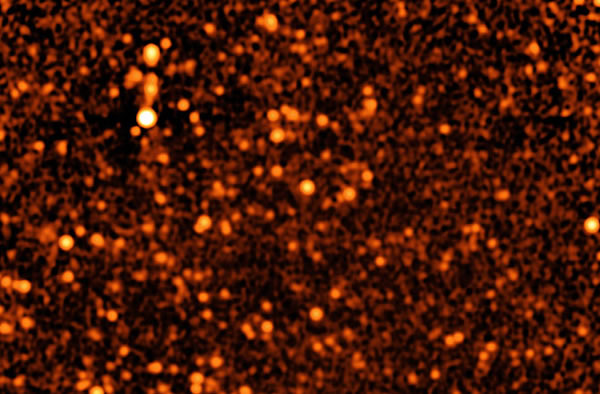Resolving the Radio Background of the Universe
Heinrich Olber asked in the early 19th century, why, if the universe was static and infinite, was the night sky dark? Nowadays we know that the universe had a beginning in the Big Bang and has been expanding ever since, making Olber’s Paradox a bit of a moot point. However, the night sky isn’t completely dark, as there is a faint background light in all directions and in all wavelengths. Astronomers using the newly revamped Karl G. Jansky Very Large Array (VLA) in New Mexico, have resolved one component of this ever present sky glow — the radio background.
The radio background (NOT to be confused with the Cosmic Microwave Background), has long been thought to consist of the combined light of radio galaxies all across the cosmos. “Radio” refers to the energy the galaxy is emitting in the radio spectrum of light — as opposed to the visible light, which we may not be able to see from galaxies so distant. But with instruments such as the VLA astronomers are able to detect the distant radio glow.
The VLA consists of 27 individual radio telescopes, each 82 feet in diameters. Together, the radio telescopes work as one giant instrument called an interferometer, which can produce high resolution maps that pin-point tiny details.
Resolving the Radio Background of the Universe
Using the VLA, astronomers focused on a patch of sky in the constellation Draco was for 57 hours. The result is the image above in which each individual dot — of 2,000 discrete sources — is likely a galaxy. Extrapolated over the entire sky, that means there would be 2 billion such objects. Previous, shallower surveys conducted using with the VLA showed the distribution of such radio galaxies to be uniform across the sky. This is largely because the era of bright radio sources is in the universe’s distant past.
Counting radio sources is not new, as the paper by Jim Condon and his colleagues states, as the first counts of “radio stars” in the 1950s showed that these objects were not stars, after all, but sources far beyond our own galaxy and further away than any optical telescopes at the time could see. But the early surveys were plagued by “confusion,” a term that in this case means the misidentification of “bumps” in sky maps due to background noise as actual sources of radio emission. The confusion limit of an interferometer must be well understood in order to make accurate maps of the sky and counts of radio galaxies. With the new, more powerful VLA and a team of scientists that are some of the black-belts of radio interferometry, they were able to accurately count 96 percent of the radio background.
With the background emission resolved, the sources themselves could be studied to see what they actually are. Sixty-three percent of the sources are powered by active galactic nuclei (AGN), or the radio emission from near a supermassive black hole that is actively eating the surrounding gas. The remaining 37 percent of the background from galaxies where star formation is proceeding rapidly. The evolution of these two populations are linked however, since galaxy mergers and interactions cause both AGN and high star formation rates, and the two processes can interact with each other within the same galaxies. The galaxies with intense star formation also give off intense infrared light, and are also the main source of the far-infrared sky glow that is seen in all directions.
Looking to the future, this source population can be extrapolated to what the Square Kilometer Array (SKA), a massive radio interferometer now under development, will see when it begins mapping the sky with unprecedented sensitivity. These results suggest that the SKA will be able to map even fainter radio galaxies without being limited by confusion imposed by having too many sources at a given brightness in the sky.
Radio interferometers can be tricky beasts, but under the right guidance and care, an immense treasure trove of information is out there waiting to be discovered.(May 11, 2013 11:00 AM ET // by Nicole Gugliucci)












